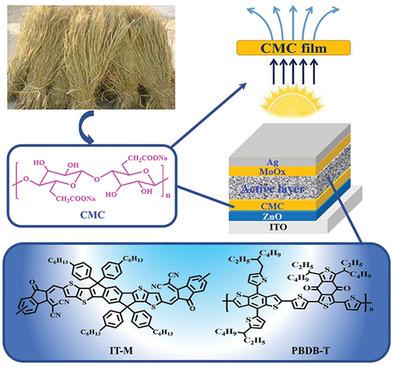Our official English website, www.x-mol.net, welcomes your
feedback! (Note: you will need to create a separate account there.)
From Straw to Device Interface: Carboxymethyl-Cellulose-Based Modified Interlayer for Enhanced Power Conversion Efficiency of Organic Solar Cells.
Advanced Science ( IF 14.3 ) Pub Date : 2019-11-27 , DOI: 10.1002/advs.201902269 Junying Wu 1 , Yanjun Liu 1 , Amjad Islam 1 , Qinghong Zheng 1 , Jianguo Li 1 , Wei Ji 2 , Lihui Chen 1 , Xinhua Ouyang 1
Advanced Science ( IF 14.3 ) Pub Date : 2019-11-27 , DOI: 10.1002/advs.201902269 Junying Wu 1 , Yanjun Liu 1 , Amjad Islam 1 , Qinghong Zheng 1 , Jianguo Li 1 , Wei Ji 2 , Lihui Chen 1 , Xinhua Ouyang 1
Affiliation

|
Advanced interface materials made from petrochemical resources have been extensively investigated for organic solar cells (OSCs) over the past decades. These interface materials have demonstrated excellent performances in OSC devices. However, the limited resources, high-cost, and non-ecofriendly nature of petrochemical-based interface materials restrict their commercial applications. Here, a facile and effective approach to prepare cellulose and its derivatives as a cathode interface layer for OSCs with enhanced performance from rice straw of agroforestry residues is demonstrated. By employing this carboxymethyl cellulose sodium (CMC) into OSCs, a highly efficient inverted OSC is constructed, and a power conversion efficiency (PCE) of 12.01% is realized using poly[(2,6-(4,8-bis(5-(2-ethyl-hexyl)-thiophen-2-yl)-benzo[1,2-b:4,5-b'] dithiophene))-alt-(5,5-(1',3'-di-2-thienyl-5',7-bis(2-ethylhexyl)benzo[1',2'-c: 4',5'-c']dithiophene-4,8-dione): 3,9-bis(2-methylene-((3-(1, 1-dicyanomethylene)-6/7-methyl)-indanone))-5,5,11,11-tetrakis(4-hexylphenyl)-dithieno[2,3-d: 2',3'-d']-s-indaceno[1,2-b: 5, 6-b']dithiophene as the active layer, which shows over 9.4% improvement in PCE compared to that of a device without the CMC layer (PCE = 10.98%), especially the enhancement in short-circuit current. The improved current densities and PCEs are attributed to the reduced work function, enhanced absorption, and improved interfacial contact by using CMC and ZnO as co-interface. This approach of fabricating interface materials from biorenewable sources for OSCs is simple, scalable, and cost-effective, representing a promising direction for the development of smart interface and green electronics.
中文翻译:

从吸管到器件界面:基于羧甲基纤维素的改性中间层可提高有机太阳能电池的功率转换效率。
在过去的几十年里,由石化资源制成的先进界面材料已被广泛研究用于有机太阳能电池(OSC)。这些界面材料在OSC器件中表现出了优异的性能。然而,石化基界面材料的资源有限、成本高且不环保,限制了其商业应用。在这里,展示了一种简便有效的方法,可以从农林业残留物的稻秆中制备纤维素及其衍生物作为 OSC 的阴极界面层,并具有增强的性能。通过将该羧甲基纤维素钠(CMC)应用于OSC,构建了高效倒置OSC,并使用聚[(2,6-(4,8-bis(5-))实现了12.01%的功率转换效率(PCE) (2-乙基己基)-噻吩-2-基)-苯并[1,2-b:4,5-b']二噻吩))-alt-(5,5-(1',3'-二- 2-噻吩基-5',7-双(2-乙基己基)苯并[1',2'-c: 4',5'-c']二噻吩-4,8-二酮): 3,9-双(2 -亚甲基-((3-(1, 1-二氰亚甲基)-6/7-甲基)-茚满酮))-5,5,11,11-四(4-己基苯基)-二噻吩并[2,3-d: 2 ',3'-d']-s-茚并烯基[1,2-b: 5, 6-b']二噻吩作为活性层,与没有 CMC 层的器件相比,PCE 提高了 9.4% 以上(PCE = 10.98%),特别是短路电流的增强。电流密度和PCE的提高归因于使用CMC和ZnO作为共界面降低了功函数、增强了吸收以及改善了界面接触。利用生物可再生来源制造 OSC 界面材料简单、可扩展且具有成本效益,代表了智能界面和绿色电子发展的一个有前途的方向。
更新日期:2019-11-28
中文翻译:

从吸管到器件界面:基于羧甲基纤维素的改性中间层可提高有机太阳能电池的功率转换效率。
在过去的几十年里,由石化资源制成的先进界面材料已被广泛研究用于有机太阳能电池(OSC)。这些界面材料在OSC器件中表现出了优异的性能。然而,石化基界面材料的资源有限、成本高且不环保,限制了其商业应用。在这里,展示了一种简便有效的方法,可以从农林业残留物的稻秆中制备纤维素及其衍生物作为 OSC 的阴极界面层,并具有增强的性能。通过将该羧甲基纤维素钠(CMC)应用于OSC,构建了高效倒置OSC,并使用聚[(2,6-(4,8-bis(5-))实现了12.01%的功率转换效率(PCE) (2-乙基己基)-噻吩-2-基)-苯并[1,2-b:4,5-b']二噻吩))-alt-(5,5-(1',3'-二- 2-噻吩基-5',7-双(2-乙基己基)苯并[1',2'-c: 4',5'-c']二噻吩-4,8-二酮): 3,9-双(2 -亚甲基-((3-(1, 1-二氰亚甲基)-6/7-甲基)-茚满酮))-5,5,11,11-四(4-己基苯基)-二噻吩并[2,3-d: 2 ',3'-d']-s-茚并烯基[1,2-b: 5, 6-b']二噻吩作为活性层,与没有 CMC 层的器件相比,PCE 提高了 9.4% 以上(PCE = 10.98%),特别是短路电流的增强。电流密度和PCE的提高归因于使用CMC和ZnO作为共界面降低了功函数、增强了吸收以及改善了界面接触。利用生物可再生来源制造 OSC 界面材料简单、可扩展且具有成本效益,代表了智能界面和绿色电子发展的一个有前途的方向。











































 京公网安备 11010802027423号
京公网安备 11010802027423号